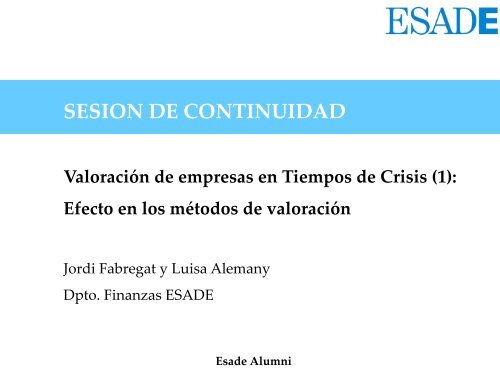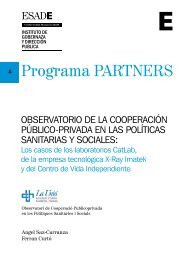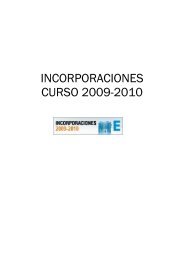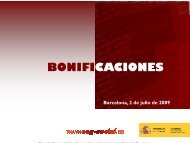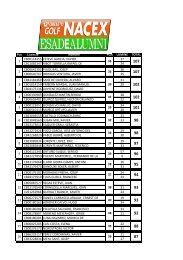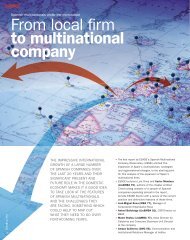Esade Alumni
Esade Alumni
Esade Alumni
You also want an ePaper? Increase the reach of your titles
YUMPU automatically turns print PDFs into web optimized ePapers that Google loves.
SESION DE CONTINUIDAD<br />
Valoración de empresas en Tiempos de Crisis (1):<br />
Efecto en los métodos de valoración<br />
Jordi Fabregat y Luisa Alemany<br />
Dpto. Finanzas ESADE<br />
<strong>Esade</strong> <strong>Alumni</strong>
ÍNDICE DE CONTENIDOS<br />
• Métodos de Valoración<br />
• Métodos Estáticos<br />
• Métodos Dinámicos<br />
– DCF: “Discounted Cash Flow”<br />
– Valoración por Dividendos<br />
• Métodos Compuestos<br />
• Método de Múltiplos<br />
•Conclusiones<br />
<strong>Esade</strong> <strong>Alumni</strong> 2
METODOS ESTATICOS<br />
VALOR SUSTANCIAL= ACTIVOS AJUSTADOS - DEUDAS<br />
No tiene en cuenta las oportunidades de crecimiento<br />
Es necesario valorar todos los activos a precios de mercado<br />
Empresas con activos intangibles son difíciles de valorar<br />
PROBLEMAS EN EMPRESAS DE SERVICIOS<br />
<strong>Esade</strong> <strong>Alumni</strong> 3
•Métodos de Valoración<br />
• Métodos Estáticos<br />
• Métodos Dinámicos<br />
– DCF: “Discounted Cash Flow”<br />
– Valoración por Dividendos<br />
• Métodos Compuestos<br />
• Método de Múltiplos<br />
•Conclusiones<br />
<strong>Esade</strong> <strong>Alumni</strong> 4
METODOS DINAMICOS<br />
• Tienen en cuenta el futuro<br />
• Basan el valor de la empresa en los activos actuales y en las<br />
oportunidades de crecimiento<br />
• Obliga a realizar hipótesis sobre el futuro de la empresa<br />
• Sirve para valorar todo tipo de empresas<br />
• Dos métodos principales:<br />
p<br />
– Flujos de Caja Descontados (DCF)<br />
– Dividendos<br />
<strong>Esade</strong> <strong>Alumni</strong> 5
Valor de Activos (EV) y Valor de<br />
Acciones (EqV)<br />
Contabilidad<br />
Valores Mercado<br />
ACTIVO<br />
PASIVO + PN<br />
Caja & IFT<br />
Capital de Trabajo<br />
Pasivo Corriente<br />
(no proveedores)<br />
Caja & IFT<br />
Deuda Financiera<br />
Deuda L/P<br />
Minoritarios<br />
Inmovilizado<br />
Fondos Propios<br />
Valor Empresa o<br />
Valor de Activos<br />
Valor Acciones<br />
“Equity Value”<br />
<strong>Esade</strong> <strong>Alumni</strong>
MEJOR METODO DE VALORACION DINAMICO: “DCF”<br />
“Discounted Cash Flow” : El valor de una empresa es igual a la<br />
suma de sus infinitos flujos de caja descontados por el coste del<br />
capital (WACC)<br />
Procedimiento para el cálculo del valor de la empresa usando DCF:<br />
0 1 2 3 4 n n +1<br />
CF1 CF2 CF3 CF4 CFn CFn+1<br />
A<br />
Perpetuidad<br />
B<br />
VT<br />
<strong>Esade</strong> <strong>Alumni</strong> 7<br />
A + B = Valor de la Empresa (Activos)<br />
(“EV” ó “FV”)
1. DETERMINACION FLUJOS DE CAJA<br />
Ventas<br />
-Costes con pago<br />
EBITDA<br />
-Amortizaciones<br />
EBIT<br />
-Impuestos<br />
EBIAT<br />
EBIAT<br />
+ Amortizaciones<br />
CF Operativo<br />
-Inv. AF (Capex)<br />
-Inv. CT (WC)<br />
Free Cash Flow<br />
(FCF)<br />
<strong>Esade</strong> <strong>Alumni</strong> 8
2. DETERMINACION DEL WACC<br />
“Weighted e Average Cost of Capital” a : Coste medio ponderado o a precios<br />
de mercado de los recursos financieros de la empresa<br />
WACC<br />
=<br />
⎛<br />
⎜<br />
⎝<br />
K<br />
FP<br />
⎞<br />
⎛<br />
e<br />
*<br />
⎟ + ⎜ K<br />
d<br />
*<br />
*<br />
TOTAL ⎠ ⎝<br />
DEUDA<br />
TOTAL<br />
⎞<br />
( 1 − T ) ⎟<br />
⎠<br />
Ke = Rf + (Rm – Rf) * B<br />
B = Beta de la empresa. Riesgo relativo de la empresa con respecto al<br />
mercado<br />
Kd = En función del rating de las Agencias (Moodys, Standard & Poors)<br />
<strong>Esade</strong> <strong>Alumni</strong> 9
BETA DE INDITEX<br />
<strong>Esade</strong> <strong>Alumni</strong>
EVOLUCION DE LOS COEFICIENTES DE CORRELACION<br />
Ante s del 11-S<br />
C31<br />
C2 21<br />
C11<br />
1<br />
C1<br />
8<br />
15<br />
22<br />
29<br />
1<br />
0,7 5<br />
0,75-1<br />
0,5<br />
0,5-0,75<br />
0,2 5<br />
0,25-0,5<br />
0 0-0,25<br />
-0 ,25<br />
-0,25-0<br />
-0 ,5<br />
-0,5--0,25<br />
-0 ,75<br />
-1<br />
- 0,7 5--0 ,5<br />
-1--0,75<br />
D espués del 11-S<br />
C23<br />
C12<br />
1<br />
C1<br />
8<br />
15<br />
22<br />
29<br />
1<br />
0,75<br />
0,5<br />
0,25<br />
0<br />
-0,25<br />
-0,5<br />
-0,7 5<br />
0,75-1<br />
0,5-0,75<br />
0,25-0,5<br />
0 -0 ,25<br />
-0,25-0<br />
-0,5--0,25<br />
- 0,7 5--0 ,5<br />
<strong>Esade</strong> <strong>Alumni</strong> 11
•Métodos de Valoración<br />
• Métodos Estáticos<br />
• Métodos Dinámicos<br />
– DCF: “Discounted Cash Flow”<br />
– Valoración por Dividendos<br />
• Métodos Compuestos<br />
• Método de Múltiplos<br />
•Conclusiones<br />
<strong>Esade</strong> <strong>Alumni</strong> 12
METODO DE VALORACION POR DIVIDENDOS<br />
El valor de las acciones de una empresa es igual a la suma<br />
de sus infinitos dividendos descontados al coste de los<br />
fondos propios (Ke)<br />
Procedimiento para el cálculo del valor de las acciones:<br />
0 1 2 3 4 n n +1<br />
D1 D2 D3 D4 Dn Dn+1<br />
A<br />
Perpetuidad<br />
B<br />
VT<br />
A + B = Valor de las Acciones<br />
(Fondos Propios)<br />
<strong>Esade</strong> <strong>Alumni</strong> 13
•Métodos de Valoración<br />
• Métodos Estáticos<br />
• Métodos Dinámicos<br />
– DCF: “Discounted Cash Flow”<br />
– Valoración por Dividendos<br />
• Métodos Compuestos<br />
• Método de Múltiplos<br />
•Conclusiones<br />
<strong>Esade</strong> <strong>Alumni</strong> 14
METODOS COMPUESTOS O MIXTOS<br />
Los métodos compuestos incorporan una parte estática y otra dinámica.<br />
• La parte estática es el valor substancial neto<br />
• La parte dinámica corresponde al fondo de comercio y existe<br />
siempre pequeo los resultados eu generados ea por la aempresa peasuperen upee el coste<br />
de los fondos propios<br />
V<br />
= VS +<br />
A<br />
¬<br />
( B −<br />
K<br />
VS<br />
)<br />
n i<br />
×<br />
e<br />
×<br />
Donde:<br />
VS = Valor Substancial<br />
B = Beneficio después de impuestos<br />
Normalmente, el valor por este método debería ser superior al estático pero<br />
inferior al dinámico.<br />
<strong>Esade</strong> <strong>Alumni</strong> 15
•Métodos de Valoración<br />
• Métodos Estáticos<br />
• Métodos Dinámicos<br />
– DCF: “Discounted Cash Flow”<br />
– Valoración por Dividendos<br />
• Métodos Compuestos<br />
• Método de Múltiplos<br />
•Conclusiones<br />
<strong>Esade</strong> <strong>Alumni</strong> 16
COHERENCIA ENTRE COMPARABLE Y EV O EqV<br />
Parámetros Financieros<br />
Valores Mercado<br />
Ventas<br />
EBITDA “Margen Operativo Bruto”<br />
Valor Activos<br />
EBIT “Margen Operativo”<br />
Beneficio Neto<br />
Dividendo<br />
Valor de FF.PP.<br />
Parámetros Operativos<br />
Valores Mercado<br />
Empleados<br />
Clientes<br />
Valor Activos<br />
Capacidad Productiva<br />
<strong>Esade</strong> <strong>Alumni</strong>
VALORACION POR MULTIPLOS<br />
• PER = Precio / Beneficio<br />
•EV/ Ventas<br />
•EV/ EBITDA<br />
• EV/ EBIT<br />
• Market to Book Value<br />
• Otros, por ejemplo: valor / metro cuadrado, valor /usuario, valor/ tonelada<br />
Nota: EV = Capitalización Bursatil + valor de mercado de la deuda<br />
<strong>Esade</strong> <strong>Alumni</strong> 18
EJEMPLO VALORACIÓN MULTIPLOS<br />
Valoración de Hidrocantábrico<br />
Compañías comparables<br />
Compañías comparables (1)<br />
Capital. Valor P / E Valor firma / EBITDA Valor firma / EBIT Deuda neta/ Crecimiento Margen EBITDA Margen EBIT<br />
Nombre Bursátil Firma 2000 2001 2002 2000 2001 2002 2000 2001 2002 Valor a L/P 2000 2001 2000 2001<br />
(€ MM) (€ MM) (x) () (x) () (x) () (x) () (x) () (x) () (x) () (x) () (x) () firma (%) (%) (%) (%) (%)<br />
EVN 1,159 1,860 13.9 13.7 14.1 8.2 8.3 8.3 15.0 15.1 14.8 36.4% na 24.7% 24.2% 13.5% 13.3%<br />
Edison 6,620 7,501 26.1 24.3 23.2 9.7 8.8 7.4 13.2 11.8 9.8 8.9% 6.8% 36.2% 37.5% 26.5% 27.7%<br />
ENEL 45,716 58,180 22.2 23.6 23.6 7.8 7.4 7.0 13.6 12.7 13.1 21.4% 6.8% 31.0% 31.3% 17.7% 18.1%<br />
Endesa 20,910 47,644 13.3 12.2 10.9 8.7 8.1 7.5 13.6 12.7 13.1 47.2% 7.1% 37.1% 38.4% 21.4% 22.6%<br />
Iberdrola 15,281 23,307307 17.1 1 15.8 14.1 1 11.1 1 10.4 95 9.5 17.3 15.8 14.3 52.3% 94% 9.4% 32.2% 2% 33.6% 20.7% 22.1%<br />
Unión Fenosa 6,246 9,898 21.8 19.2 16.8 10.5 9.1 8.5 17.0 13.3 12.2 33.6% 12.3% 25.6% 28.3% 15.8% 19.4%<br />
Mean 19.1 18.1 17.1 9.3 8.7 8.0 15.0 13.6 12.9 33.3% 8.5% 31.1% 32.2% 19.3% 20.5%<br />
Median 19.5 17.5 15.5 9.2 8.5 7.9 14.3 13.0 13.1 35.0% 7.1% 31.6% 32.5% 19.2% 20.7%<br />
EDP 9,540 13,881 17.3 16.4 14.1 8.3 7.7 7.9 13.2 11.7 12.2 31.3% 11.0% 50.6% 51.1% 31.9% 33.6%<br />
Hidrocantábrico 3,062 3,819 25.3 22.7 19.5 11.1 10.6 9.2 16.9 15.4 13.1 19.8% 14.0% 29.5% 36.0% 19.4% 22.4%<br />
<strong>Esade</strong> <strong>Alumni</strong> 19
EJEMPLO TRANSACCIONES PRECEDENTES<br />
Valoración de Hidrocantábrico<br />
Valor Agregado / EBITDA U12M<br />
(x)<br />
16<br />
14.90<br />
14<br />
12<br />
10<br />
10.30<br />
8.70<br />
11.30<br />
10.90<br />
12.30<br />
8.80<br />
10.10<br />
10.50<br />
11.50<br />
Mediana<br />
10.5x<br />
8<br />
7.40<br />
6<br />
4<br />
2<br />
0<br />
U. Fenosa/National Power<br />
E Wesertal/Fortum<br />
Ferroatlantica Bid<br />
Iberdrola/Endesa<br />
REMU/Endesa<br />
Sydkraft/EON<br />
HEW/Waterfall<br />
BKK/Statkraft<br />
Hedmark Energi/Statkraft<br />
TXU bid for HC<br />
Union Fenosa bid for HC<br />
El múltiplo clave que se utiliza en la valoración por transacciones precedentes de compañías<br />
del sector eléctrico es el Valor Agregado sobre EBITDA de los últimos doce meses<br />
<strong>Esade</strong> <strong>Alumni</strong> 20
MULTIPLOS: EL “PER”<br />
¿Qué variables pueden afectar al PER de una empresa?<br />
Fórmulas básicas:<br />
PER =<br />
Precio por acción<br />
Beneficio por acción<br />
ROE =<br />
Beneficio<br />
Valor contable<br />
D<br />
−<br />
1<br />
=<br />
K e<br />
Precio Acción<br />
g = ROE * (1 - d)<br />
g<br />
PER =<br />
d<br />
Ke - g<br />
=<br />
ROE - g<br />
ROE ( Ke - g )<br />
<strong>Esade</strong> <strong>Alumni</strong> 21
FACTORES QUE AFECTAN AL PER<br />
• Beneficio Futuro (ROE)<br />
• El crecimiento de los beneficios ( g )<br />
• La Tasa de Reparto de dividendos (PAYOUT)<br />
• El riesgo y los tipos de interes ( Ke )<br />
Factores<br />
PER<br />
Si Beneficio Futuro<br />
Si Tipos de Interés<br />
Si Crecimiento<br />
Si payout<br />
Depende si<br />
ROE > Ke<br />
<strong>Esade</strong> <strong>Alumni</strong> 22
DESCOMPOSICION DEL PER<br />
Podemos descomponer el PER entre el valor de los activos actuales y la<br />
aportación de las oportunidades de crecimiento<br />
PER =<br />
1<br />
Rf<br />
-<br />
Ke - Rf<br />
Ke * Rf<br />
+ FF * G<br />
PER sin crecimiento (*)<br />
Aportación del VAOC<br />
FF = Factor Franquicia. Indica la calidad del crecimiento<br />
FF = ( ROE - Ke ) / ( ROE * Ke)<br />
G = Indica la cantidad del crecimiento<br />
G = g / ( Ke - g )<br />
(*) Nota: PER sin crecimiento = 1 / Ke<br />
<strong>Esade</strong> <strong>Alumni</strong> 23
VALOR DE MERCADO (VM) VS. VALOR CONTABLE<br />
(VC)<br />
PRECIO PRECIO BENEFICIO<br />
= *<br />
V.Contable BENEFICIO V.Contable<br />
VM / VC = PER * ROE<br />
<strong>Esade</strong> <strong>Alumni</strong> 24
g= b * Roa<br />
DESARROLLO MÚLTIPLOS HABITUALES<br />
A partir de:<br />
Inversión neta = b * Ebiat<br />
d= Amortización/ Ebitda<br />
Ebiat= Ebit * (1T)<br />
1-T Ebit= Ebitda - Amortización<br />
EV<br />
FCF<br />
=<br />
Wacc − g<br />
=<br />
Ebiat<br />
Wacc − g<br />
Ebiat *<br />
g<br />
⎜<br />
⎛1<br />
−<br />
=<br />
⎝<br />
Wacc − g<br />
*(( 1−<br />
b<br />
)<br />
Roa<br />
⎟<br />
⎞<br />
⎠<br />
<strong>Esade</strong> <strong>Alumni</strong> 25
Llegamos a<br />
EV<br />
ebitda<br />
Roa − g<br />
= * 1−T<br />
* 1−<br />
d<br />
Roa*<br />
Wacc − g<br />
( )<br />
( ) ( )<br />
EV<br />
Ebit<br />
Roa − g<br />
= * 1<br />
Roa<br />
*(( Wacc<br />
−<br />
g<br />
)<br />
( − t)<br />
EV<br />
Ebiat<br />
=<br />
Roa −<br />
g<br />
Roa * Wacc −<br />
( g)<br />
<strong>Esade</strong> <strong>Alumni</strong> 26
•Métodos de Valoración<br />
• Métodos Estáticos<br />
• Métodos Dinámicos<br />
– DCF: “Discounted Cash Flow”<br />
– Valoración por Dividendos<br />
• Métodos Compuestos<br />
• Método de Múltiplos<br />
• Conclusiones<br />
<strong>Esade</strong> <strong>Alumni</strong> 27
S&P INDEX DESDE 1825 A 2007<br />
<strong>Esade</strong> <strong>Alumni</strong>
<strong>Esade</strong> <strong>Alumni</strong>
<strong>Esade</strong> <strong>Alumni</strong>
<strong>Esade</strong> <strong>Alumni</strong>
<strong>Esade</strong> <strong>Alumni</strong>
EVOLUCIÓN DEL INDICE S&P<br />
<strong>Esade</strong> <strong>Alumni</strong>
PER HISTORIC0 DEL INDICE S&P<br />
<strong>Esade</strong> <strong>Alumni</strong> 34
PER HISTORICO DEL IBEX<br />
<strong>Esade</strong> <strong>Alumni</strong> 35
LOS PER A 12 MESES<br />
26/9/08<br />
30<br />
25<br />
20<br />
15<br />
10<br />
5<br />
89 90 91 92 93 94 95 96 97 98 99 00 01 02 03 04 05 06 07 08<br />
S&P 500<br />
MOYENNE MSCI EMU<br />
CAC 40<br />
MSCI EMU<br />
Source: DATASTREAM<br />
<strong>Esade</strong> <strong>Alumni</strong> 36
PRIMA DE RIESGO DEL INDICE S&P<br />
S&P 500<br />
<strong>Esade</strong> <strong>Alumni</strong> 37
PRIMA DE RIESGO DE MS EMU<br />
<strong>Esade</strong> <strong>Alumni</strong> 38
¿ Y LA CONCLUSIÓN ?<br />
........ DESPUES DE LUISA<br />
<strong>Esade</strong> <strong>Alumni</strong> 39


